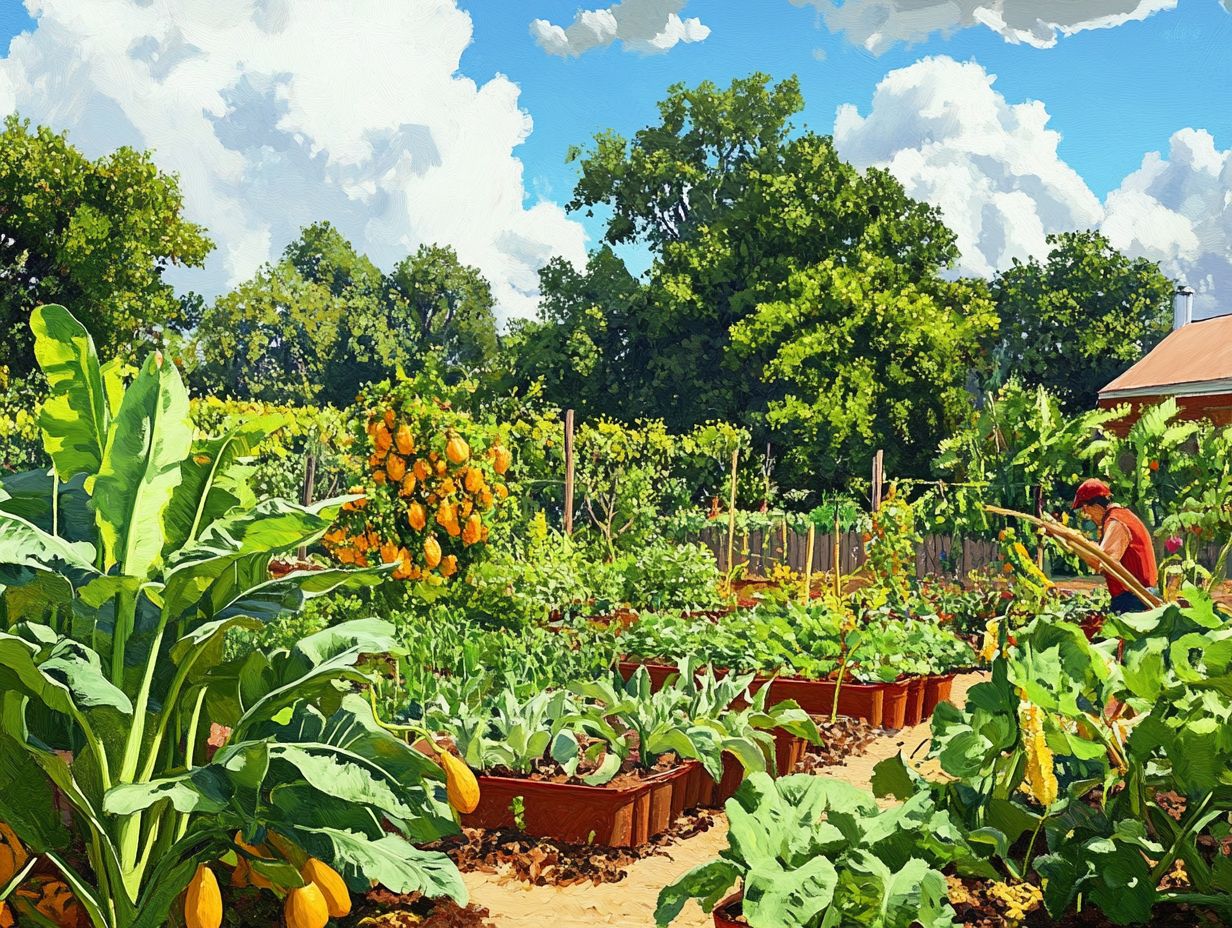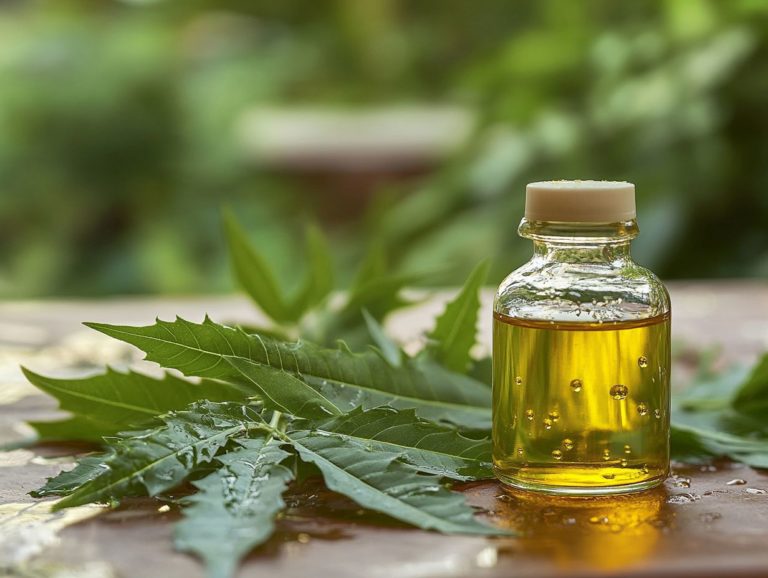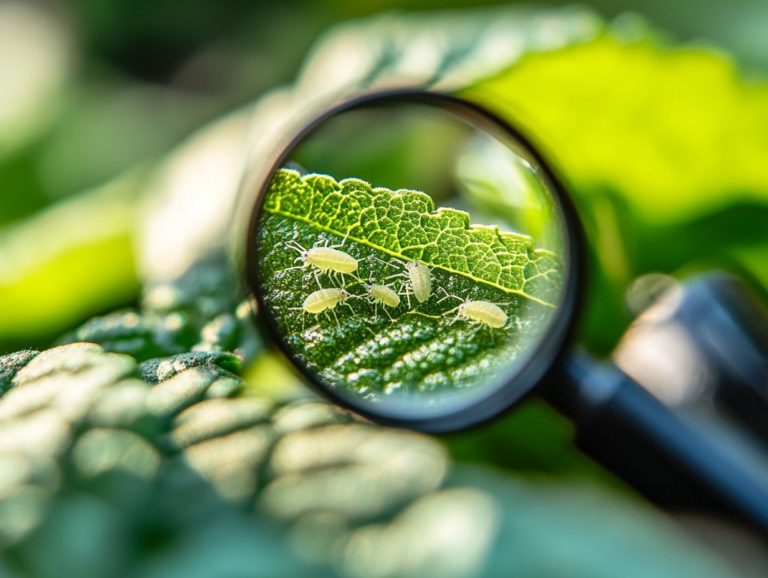How Weather Affects Pest Populations in Gardens
Gardening enthusiasts understand that weather is pivotal not just for plant health, but also for the intricate web of pest populations.
From blistering heat waves to relentless downpours, the shifting temperatures and weather patterns create a dynamic landscape that can either invite or deter pest outbreaks.
This article delves into how elements like temperature, rainfall, and wind shape pest behavior. It provides you with practical strategies to tackle these challenges as the seasons change.
Prepare to arm yourself with insights that will safeguard your garden from unwanted visitors, no matter what the weather throws your way!
Contents
- Key Takeaways:
- Impact of Temperature on Pest Populations
- Effects of Rainfall on Pest Populations
- Wind and Its Influence on Pest Populations
- Other Weather Factors that Affect Pest Populations
- How to Manage Pest Populations in Different Weather Conditions
- Frequently Asked Questions
- How does weather affect pest populations in gardens?
- What types of weather can cause an increase in pest populations in gardens?
- How does cool weather affect pest populations in gardens?
- Can a lack of rain affect pest populations in gardens?
- What role does wind play in pest populations in gardens?
- Is there a particular warm season when weather has the biggest impact on pest populations in gardens?
Key Takeaways:

- Extreme temperatures, both hot and cold, can significantly impact pest populations in gardens. It’s important to monitor and adapt pest control methods accordingly during these weather conditions.
- Rainfall, specifically drought and flooding, can greatly influence pest populations. Be aware of and respond to changes in rainfall patterns to manage these populations.
- Wind can also play a role in the spread and survival of pests. Understanding how wind affects pests can help in implementing effective pest control measures.
Understanding the Relationship
Understanding the intricate relationship between weather and pest populations is essential for effective pest management and agricultural success. As climate change continues to shift weather patterns, you will notice its impact on temperatures, rainfall, and other environmental factors that can either suppress or amplify pest populations.
You must adapt your pest control methods to counter the dynamic behaviors of agricultural pests influenced by these changing conditions. This adaptation ensures sustainable crop production and bolsters food security.
Consider this: warmer temperatures can lead to a spike in pest populations like aphids and beetles, which thrive in milder climates. Heavy rainfall creates conditions for fungal infections and can exacerbate diseases in your crops.
The emergence of new pest pressures in regions previously untouched underscores the necessity for adaptive strategies. Recent data suggests that shifting climate zones may allow certain pests to dramatically expand their range, presenting significant threats to food production across different landscapes.
As these challenges mount, pest control shifts from being just another strategy to becoming a vital component in maintaining agricultural resilience against evolving pest dynamics.
Impact of Temperature on Pest Populations
Temperature plays a crucial role in influencing pest populations. It affects their behaviors, survival rates, and generation cycles. When temperatures rise, pests such as aphids, spider mites, and root weevils often experience accelerated life cycles, leading to a surge in their numbers. Conversely, cooler weather tends to suppress these populations.
By grasping these temperature-related dynamics, you can develop effective pest management strategies that cater to both warm and cool seasons. This approach ultimately ensures the sustainability of agricultural production.
Take action now! Apply these strategies to your garden and protect your plants from the uncertainties of weather.
Effects of Hot and Cold Weather
Both hot-dry conditions and cooler weather are important in shaping pest populations and their behaviors. They directly influence agricultural insects and their impact on your crops. In hot-dry conditions, pests often enjoy heightened survival rates, leading to increased populations.
Cool weather stresses certain species, resulting in reduced numbers. Recognizing these patterns is crucial for you to develop pest control strategies that adapt to the whims of the weather.
Take the corn earworm, for instance. It thrives in above-average temperatures, which allow for faster reproduction rates and extended active seasons. Stay ahead of pest threats by monitoring temperatures closely. In contrast, cooler temperatures can slow down the development of pests like aphids, leading to fewer infestations that ultimately benefit your crop yields.
Understanding how these specific pests interact with extreme weather is essential for you as a farmer or agricultural expert. This knowledge helps you act swiftly with timely interventions and management practices. By adapting your pest management strategies, you not only safeguard your crops but also promote sustainable agricultural practices in this era of climate variability.
Effects of Rainfall on Pest Populations

Rainfall, whether abundant or lacking, significantly influences pest populations and the overall vitality of agricultural ecosystems. When rains are excessive, they can foster conditions that benefit certain pests, such as fungal diseases and invasive species.
Conversely, drought can place stress on plants, rendering them more vulnerable to pest infestations. By implementing effective pest monitoring amidst fluctuating rainfall patterns, you can greatly enhance your pest management strategies, thereby safeguarding the stability of agricultural production.
Drought and Flooding
Drought and flooding are extreme weather events that profoundly impact pest survival and behavior. They disrupt the delicate ecological balance within agricultural systems. When drought strikes, plants become stressed and more susceptible to pests like aphids and lace bugs.
On the flip side, flooding can create an inviting environment for other pests and diseases to thrive. Grasping these ecological dynamics is crucial for developing effective pest management strategies.
As a farmer, it’s essential to recognize that the interplay between drought and flooding can create a cycle that worsens crop health challenges. For example, when drought-stressed plants become hosts for aphids, their populations can surge, leading to serious infestations. Conversely, excessive moisture from flooding promotes fungal growth and attracts pests that flourish in wet conditions.
To tackle these issues, implementing integrated pest management (IPM) techniques is vital. IPM means using a combination of strategies to manage pests sustainably. Regular monitoring, crop rotation, and utilizing resistant plant varieties can help cultivate a more resilient agricultural ecosystem.
Wind and Its Influence on Pest Populations
Wind is an often-overlooked yet crucial environmental factor that significantly influences pest populations and their movements across agricultural landscapes.
Strong winds can disperse pests along with their natural predators, impacting their survival rates and the overall effectiveness of your pest control strategies.
Grasping the role of wind in pest dynamics is essential for you as a farmer or pest management professional, enabling you to enhance agricultural production effectively.
How Wind Can Affect Pests
Wind plays a crucial role in shaping pest behavior and how pest populations change. It significantly influences how agricultural pests spread and interact with their environment. High winds can carry pests over considerable distances, leading to new infestations in areas that were previously unaffected.
Take action now to boost your pest monitoring and control strategies to ensure effective management.
For example, wind can shift migration patterns, prompting certain species to traverse extensive stretches of land, which impacts their population distribution. The wind also affects temperature and humidity levels, influencing reproduction rates. Some pests thrive under conditions created by gusty winds.
To counter these factors, integrated pest management a strategy that combines different methods to control pests often incorporates real-time weather monitoring systems. This helps you predict when pests might invade, so you can act quickly!
By strategically placing traps in areas influenced by wind patterns, you can detect and mitigate pest populations more effectively.
Other Weather Factors that Affect Pest Populations

Beyond just temperature, rainfall, and wind, consider other critical weather factors like humidity and sunlight. These factors significantly influence pest populations and their behaviors.
Elevated humidity levels can boost the survival and reproduction rates of pests. Sufficient sunlight is essential for maintaining plant health, which subsequently impacts pest dynamics.
By grasping these environmental factors, you can develop more effective pest management strategies tailored to your specific situation.
Humidity, Sunlight, and Other Factors
Humidity and sunlight are essential environmental factors that can greatly influence pest survival and agricultural production. High humidity can ramp up pest activity and survival rates, while optimal sunlight nurtures plant health, which is vital for fending off pests.
A comprehensive understanding of these elements is paramount for crafting effective pest management strategies.
Take aphids and spider mites, for example. They thrive in humid conditions and can multiply quickly when moisture levels rise, posing a significant threat to your crops.
On the flip side, pests like leafcutter ants thrive in drier climates, indicating that variations in humidity can inform targeted control measures.
Sunlight serves a dual purpose; it strengthens plant resilience but can also induce stress when heat becomes excessive, making plants more vulnerable to infestations.
Timing your application of natural repellents for the late afternoon can harness sunlight s benefits, creating an unwelcoming environment for pests while protecting your crops health. Understanding the generation rates of these pests is also important.
How to Manage Pest Populations in Different Weather Conditions
Managing pest populations in the face of fluctuating weather conditions demands a sophisticated approach. You need to integrate a variety of pest control strategies while keeping a keen eye on environmental factors, including CO2 levels and humidity.
Climate extremes can significantly influence pest behaviors and how pest populations change. It s crucial for you to adapt your pest management techniques. This adaptability not only safeguards food security but also promotes sustainable agricultural production in the face of climate change.
Start implementing these strategies today to protect your crops!
Adapting Pest Control Methods
Adapting your pest control methods to align with ever-changing weather conditions is crucial for effective pest management in agriculture. Embracing methods that combine different pest control strategies, while considering environmental stress and pest monitoring, allows you to tailor interventions that are efficient and environmentally sound.
By understanding how insect threats behave in relation to climatic fluctuations, you can enhance your crop production sustainably. For example, adjusting the timing of your pesticide applications or selecting resistant crop varieties can significantly mitigate pest pressure under varying temperatures and humidity levels.
You should implement regular monitoring techniques, such as traps and visual inspections, to track pest populations and assess their impact in real-time. This is crucial for protecting your crops! This is especially important as fungal diseases, which can harm plants, thrive in certain weather conditions.
Using natural predators to control pests offers a dynamic approach to managing pest populations while reducing your reliance on chemicals. This holistic perspective boosts your yield and plays a vital role in safeguarding the ecosystem, ensuring long-term agricultural viability amid climate variability and extreme weather.
Frequently Asked Questions

How does weather affect pest populations in gardens?
Weather plays a major role in pest populations as it impacts their survival, reproduction, and migration patterns, especially under hot-dry conditions.
What types of weather can cause an increase in pest populations in gardens?
Warm, humid, and wet weather creates ideal breeding grounds for pests, leading to an increase in their populations. Additionally, excessive rains can exacerbate this issue.
How does cool weather affect pest populations in gardens?
Cool weather can decrease pest populations in gardens by slowing down their metabolism and reproduction, possibly even leading to their death.
Can a lack of rain affect pest populations in gardens?
Yes, a lack of rain can lead to drought conditions, causing stress on stressed plants and making them more vulnerable to infestations. This can result in an increase in pest populations, particularly among agricultural insects.
What role does wind play in pest populations in gardens?
Strong winds can physically damage plants, making them more susceptible to attacks. Wind can also carry pests to new areas, spreading their populations and influencing their survival.
Is there a particular warm season when weather has the biggest impact on pest populations in gardens?
Different pest species thrive in various weather conditions, but generally, warmer months with high humidity during the warm season can lead to an increase in pest populations. However, extreme weather events, like floods or droughts, can significantly impact pest populations throughout the year, affecting food safety.
Act now to adapt your pest control methods to protect your crops!






